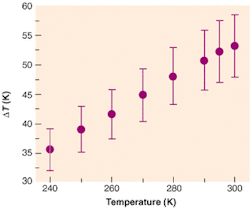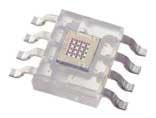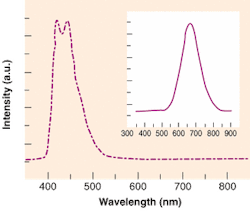Newsbreaks
Violet-emitting laser diode is frequency stabilized
As violet-emitting semiconductor lasers based on gallium arsenide become longer-lived and more widely used, they also become the object of development intended to fit them into roles traditionally played by other lasers. For example, a frequency-stabilized violet-emitting semiconductor laser that could be detuned in a stable manner from the stabilization-line center would be useful in high-resolution spectroscopy and laser cooling and trapping. Scientists at the Korea Research Institute of Standards and Science (Daejeon, Korea) have created just such a device.
An extended-cavity laser diode was stabilized to the 398.9-nm Doppler-broadened 1S0-1P1 transition of ytterbium (Yb) atoms emitted by a hollow-cathode lamp. A modulation-free dichroic-atomic-vapor laser-lock technique used a weak magnetic field to split the Zeeman components of the transition signal, generating an error signal depending on the difference in absorption rates of the two components of circularly polarized light. The laser emitted 15 mW of light and had a long-term frequency stability of 1 MHz over a period of 15 hours. The researchers are now using the laser to trap Yb atoms, which have an excited-state linewidth of 28 MHz. Contact Tai Hyun Moon at [email protected].
Optical-delay circuit exploits parametric wavelength conversion
Researchers at NTT Photonics Laboratories (Kanagawa, Japan) and the University of Tokyo (Tokyo, Japan) have developed an all-fiberoptic variable-optical-delay circuit that is based on nonlinear conversion of wavelength. The circuit is expected to be used for optical-packet switching—which itself is still in the research stage. Incorporating a highly nonlinear fiber parametric wavelength converter, the circuit inputs an optical pulse into a loop of fiber containing the wavelength converter. Each time the pulse circulates, it is shifted in wavelength by an increment. When the wavelength reaches a predetermined output wavelength, the pulse leaves the loop; the result is a delay time that depends on the wavelength of the input pulse.
In a test, an input pulse with a 1554.1-nm wavelength circulated five times with no penalty, each time shifted in wavelength by -0.8 nm. The signal was extracted by an optical drop module based on a thin-film filter. No separate amplifier was required to compensate for circulation loss. If the number of circulations can be boosted, the device would become a large-scale optical-packet buffer. Contact Morito Matsuoka at [email protected].
Photodiodes show efficient negative luminescence
A phenomenon called negative luminescence is at the heart of devices being characterized by scientists at the Naval Research Laboratory (Washington, DC) and Raytheon Vision Systems (Goleta, CA). When the bias is reversed on a photovoltaic device, carriers can be swept out, reducing the radiative emission and making the device appear colder than a blackbody object at the same temperature. Such devices could be used for cold-shielding of infrared (IR) focal-plane arrays, as a reference for quickly performing multipoint nonuniformity correction in such arrays, or as a broadband IR source for infrared spectroscopy.
The researchers studied midwave-infrared mercury cadmium telluride photodiodes fabricated at Raytheon. Grown on silicon substrates using molecular-beam epitaxy, the devices had a 5-µm-thick active region and a cutoff wavelength of 5.3 µm at 295 K. An 88% internal efficiency in the 3- to 5-µm spectral region translated into an apparent temperature reduction (ΔT in this plot) of 50 K at room temperature and 35 K at 240 K under reverse bias. Seven devices made on the same chip all functioned, indicating that the devices could be made with high yield. The reverse-saturation current density of 1.3 A/cm2 is the lowest reported for such a device with cutoff wavelength beyond 4 µm. Contact Ryan Lindle at [email protected].
Top-emitting LEDs are best for electron-spin detection
Based on electrical injection and detection of spin-polarized current, semiconductor spintronics could become the basis for next-generation computer hardware. Detecting spin-polarized current can be done by driving certain types of light-emitting diodes (LEDs) with the current and measuring the degree of circular polarization of the emitted light, which is proportional to the spin polarization of the carriers. Researchers at Würzburg University (Würzburg, Germany) have looked at both top- and side-emitting versions of such a device, determining that side emitters could not reliably be used for indicating spin-polarized electron injection.
Fabricated from aluminum gallium arsenide with a zinc beryllium manganese selenide spin injector, the LEDs emit at 813 nm (1.5254 eV). A top-emitter with a 500-µm mesa size exhibited strong polarization, reaching a maximum of 0.68 for an applied magnetic field of 2T. Top-emitters with mesa sizes of 1 and 5 µm exhibited smaller, but still substantial, polarizations. Side-emitters with the same mesa sizes exhibited no polarization (the testing of small-mesa devices eliminated multiple reflections and resonant pumping as the reason for such poor performance of the side emitters). Contact Roland Fiederling at [email protected].
Laser probes megagauss magnetic fields in plasma
Characterization of transient magnetic fields in plasmas is important for understanding inertial-confinement fusion (ICF), as well as testing astrophysical theories in the laboratory. Researchers at the Tata Institute for Fundamental Research (Mumbai, India) and the Institute for Plasma Research (Ahmedabad, India) have created 6-ps, 27-megagauss magnetic pulses in overdense plasma and followed their temporal evolution at the plasma's critical layer with high resolution, observing for the first time anomalously rapid damping of plasma shielding currents (produced in response to hot electron currents penetrating the bulk plasma).
The plasma is produced by focusing an 806-nm 100-fs laser pulse on a solid aluminum target, producing an intensity of 1016 W/cm2. A small fraction of the laser beam is split off and frequency-doubled to form a probe pulse at an intensity of 5 × 1012 W/cm2; the change in polarization of the linearly polarized probe pulse is measured. The results may be the first ever to experimentally indicate turbulence-induced anomalous resistivity, of interest to fast-ignition ICF. Contact G. Ravindra Kumar at [email protected].
Integrated color sensor is digitally compatible
A color sensor commercially introduced by Texas Advanced Optoelectronic Solutions (Plano, TX) is claimed to be the first integrated red-green-blue color sensor with a digital-compatible interface. The device contains silicon photodiodes and a programmable current-to-frequency converter on a monolithic complementary metal-oxide semiconductor integrated circuit. Its output is a square wave (50% duty cycle) with frequency directly proportional to irradiance, with a typical output frequency range of 2 Hz to 500 kHz.
The device reads an 8 × 8 array of photodiodes—16 with blue filters, 16 with green, 16 with red, and 16 with no filters. The photodiodes are 120 × 120 µm in size and are on 144-µm centers. The four colors are interdigitated to minimize the effect of nonuniformity of incident irradiance. All 16 photodiodes of the same color are connected in parallel and which type of photodiode the device uses during operation is pin-selectable. The sensor is intended for use in colorimeter measurement applications such as color printers, medical diagnostics, computer monitor calibration, process controls, and color-matching applications with paints, textiles, cosmetics, and printed materials. Contact Jack Berlien at [email protected].
Silicon microdischarge devices serve as avalanche photodetectors
Silicon (Si) microdischarge devices filled with gases such as neon have been made into arrays potentially useful as displays (see Laser Focus World, March 2002, p. 9). But, just as some other types of light emitters can (with modifications) be used to detect light, so can microdischarge devices. Researchers at the University of Illinois have fabricated 50- and 100-µm-square microdischarge devices with inverted pyramid shapes filled with neon. The Si serves as a photocathode and the gas, which turns into a plasma, serves an avalanche photomultiplier for radiation at wavelengths from 350 to 1200 nm.
The devices are formed by a wet-etch process and are excited with direct current. In one example, a 100-µm-square device is filled with neon to a pressure of 500 Torr. The sensor exhibits room-temperature responsivities of 570 and 700 A/W at wavelengths of 660 and 850 nm respectively, which is more than ten times the responsivities of commercially available Si avalanche photodiodes. The smaller 50-µm-square detectors have a peak sensitivity at 600 to 650 nm—for example, 950 A/W at 625 nm. Contact Gary Eden at [email protected].
Quantum-cascade lasers go nonlinear
The quantum-cascade (QC) laser is proving to be versatile in its permutations, with versions emitting terahertz radiation, two wavelengths simultaneously, and even radiation over a supercontinuum (see Laser Focus World, May 2002, p. 32). Now, researchers at Lucent Technologies' Bell Labs (Murray Hill, NJ) and Texas A&M University (College Station, TX) are producing resonant second-order nonlinear optical processes in QC lasers—both sum-frequency and second-harmonic generation.
A two-wavelength QC laser is fabricated that emits at 7.1 and 9.5 µm. The laser is operated in a pulsed mode. The indium gallium arsenide/aluminum gallium arsenide heterostructure provides two sources of nonlinearity, one in the 7.1-µm laser itself and the other in a superlattice between the two lasing regions. These nonlinear regions produce sum-frequency radiation at 4.1 µm and second-harmonic radiation at 3.6 and 4.7 µm. Fundamental peak powers are 60 and 80 mW, with sum-frequency and second-harmonic peak powers of 30 and 15 nW. An improved waveguide design should boost the mixing signal power by two to three orders of magnitude, according to the researchers. Contact Claire Gmachl at [email protected].
Blue-emitting porous silicon is stable in air
Porous silicon (Si) can emit light at visible wavelengths. If stable and efficient red-, green-, and blue-emitting devices based on this phenomenon could be developed, then flat-panel displays could be made from Si, taking advantage of the vast integrated-circuit chipmaking infrastructure to help reduce manufacturing costs. One problem with porous Si is its lack of stability: oxidation of the material in air quenches the luminescence. Now, researchers at the University of Science and Technology of China (Hefei, China) have developed a blue-emitting porous-Si material that remains stable even after a year's exposure to air.
Hydrothermal etching of single-crystal Si in hydrofluoric acid, followed by pulsed-laser-ablation deposition of a thin film of ferroelectric material, produces the stable porous Si. In photoluminescence experiments (256-nm laser excitation), the electrostatic field induced by the ferroelectric material separates the electrons and holes produced by the silicon nanocrystallites, which migrate to the interface between the Si and the ferroelectric material, then recombine to produce light over a wavelength band of 400 to 500 nm (the usually observed 680-nm porous-Si emission was absent). Contact Qianwang Chen at [email protected].



